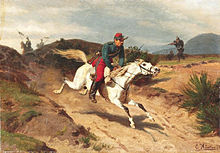Hunters on horseback

The hunters on horseback (French: Chasseurs à cheval , English Mounted Riflemen or Mounted Rifles ) were a type of light cavalry that was mainly used for reconnaissance and security tasks.
assignment

Similar to the hussars , the hunters on horseback served primarily for reconnaissance and security tasks, but were also increasingly used as battle cavalry. The guard hunters on horseback of Napoleon I also served as staff cavalry (as messenger riders, covering the headquarters and personal escort of the emperor).
history
The hunters on horseback appeared in the middle to the end of the 18th century when the need for regular light cavalry was recognized, but shied away from the cost of setting up elaborately uniformed hussar units .
Forerunners in France were some voluntary corps, for example the fishermen hunters established in 1743. In 1779 there were six line cavalry regiments for the first time, other countries such as Russia (1790–1882, finally 19 regiments ), Austria (one regiment, 1798–1801), Italy (four regiments, 1805–1814) and the USA (a regiment 1846-61) followed. In Napoleonic France , the branch of arms grew to 31 regiments of the line and 2 regiments of the guards ; after the Restoration, 24 regiments of the line and one of the guards remained, to which four Chasseurs d'Afrique regiments set up in Algeria were added in 1831 , which soon became the best cavalry troops in the French army were valid. In Belgium the three regiments formed in 1830/31 were disbanded in 1994 and 2004 respectively.
It was not until 1901 that the first regiment of the Prussian army (King Jäger on Horseback No. 1) was set up. This was followed by No. 2 and 3 in 1905, No. 4 in 1906, No. 5 in 1908 and No. 6 in 1910 . In 1913 regiments No. 7 , 8 , 9 , 10 , 11 , 12 and 13 were set up.
In the trench warfare of the First World War cavalry general lost its importance and was mostly infantry used. In the Reichswehr , a distinction was no longer made between individual troop gates such as hussars, dragoons, cuirassiers or hunters on horseback; the tradition of the regiments of the old army did not go over to the cavalry regiments of the Reichswehr according to type of troop, but from a country-man point of view and was blurred with it Completion of the Wehrmacht in 1935.
In France, the name “Chasseurs à Cheval” remained for a long time, even though the regiments became mechanized infantry , tank reconnaissance or armored troops over the years . It was not until the end of the 20th century that the addition of "à Cheval" was dropped, although the remaining regiments, 1 er régiment de chasseurs , 4 e régiment de chasseurs and 1er régiment de chasseurs d'Afrique continue their cavalry tradition.
Appearance
The uniform was often based on that of the hussars, but was usually less elaborate and mostly green. In France, she was bottle green with collar and cuffs in facing color , which initially supported Raupenhelm in Tarletonstil more during the Revolution wing cap and finally Shako or (in the elite companies and the Old Guard) Kolpak . In Austria a gray uniform according to the Chevauleger style was worn, in Russia a green dragoon uniform , but with shakkos instead of helmets. The Chasseurs d'Afrique received light blue skirts. In 1873 the Attila also turned light blue in the French line regiments .
Since in the German Reich the Meldereiter detachments, from which the first regiments emerged, were initially assigned to the guards, their uniform was initially based on that of the heavy guards cavalry despite their role as light cavalry (i.e. Koller and metal cuirassier ax hood with a deep brim) , but was gray-green for all types of suits from the start. In 1910 the rollers were abolished for the existing regiments and replaced by tunics. A gray-green uniform based on the pattern of the Dragoons was issued for regiments No. 8 to 13, which were newly established in 1913. The officers of these new regiments, however, wore the cuirassier helmet.
The armament consisted of a sword or pallasch and the carbine . In Prussia the hunters on horseback, like the whole cavalry, also carried lances .
Mounted hunters with a different mission
The Feldjägerkorps on horseback set up in Prussia in 1740 (from 1756 Reitendes Feldjägerkorps ), however, only served as a staff cavalry.
The Mounted Rifles of some states of the British Empire, such as the Australian Light Horse Regiment or New Zealand's New Zealand Mounted Rifles Brigade , set up in the late 19th century , were not cavalry in the true sense, but rather represented mounted infantry - a development that indicated the way forward for the future role of cavalry in the 20th century.
The volunteer hunters of Prussia and some other German states should not be confused with the hunters on horseback . During the Wars of Liberation, these were set up from wealthy volunteers and detached from the regular associations to support them in their respective tasks.
literature
- Richard Knötel , Herbert Knötel and Herbert Sieg: Colored Handbook of Uniform Studies. (Reprint), Herbig, Munich 2000, ISBN 3-7766-2144-3




